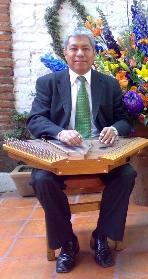|
Salterio (Mexico)
The salterio mexicano is a string instrument String instruments, stringed instruments, or chordophones are musical instruments that produce sound from vibrating strings when a performer plays or sounds the strings in some manner. Musicians play some string instruments by plucking the ..., with origins in the 16th century psaltery. It is manufactured with woods forming a trapezoidal box. On the top board, 5 bridges are placed in order to seat stretched metal strings across from side to side. The strings are plucked with a metal pick adjusted on the index finger of each hand. There are salterios of various sizes, up to one meter long, with tessitura of tenor, soprano and requinto. The salterio requinto has 90 strings in 3 course, with a range from Si4 to Fa#9. The salterio tenor has more than 100 strings in 3-4 course order, with a range from Si3 to Fa#8. References (1988). Instituto Nacional de Antropología e Historia. ''Atlas Cultural de México. Música.'' Grupo E ... [...More Info...] [...Related Items...] OR: [Wikipedia] [Google] [Baidu] |
String Instrument
String instruments, stringed instruments, or chordophones are musical instruments that produce sound from vibrating strings when a performer plays or sounds the strings in some manner. Musicians play some string instruments by plucking the strings with their fingers or a plectrum—and others by hitting the strings with a light wooden hammer or by rubbing the strings with a bow. In some keyboard instruments, such as the harpsichord, the musician presses a key that plucks the string. Other musical instruments generate sound by striking the string. With bowed instruments, the player pulls a rosined horsehair bow across the strings, causing them to vibrate. With a hurdy-gurdy, the musician cranks a wheel whose rosined edge touches the strings. Bowed instruments include the string section instruments of the orchestra in Western classical music (violin, viola, cello and double bass) and a number of other instruments (e.g., viols and gambas used in early music from the Baro ... [...More Info...] [...Related Items...] OR: [Wikipedia] [Google] [Baidu] |
Salterio Player In Mexican Typical Orchestra 1885
Salterio is the Italian, Spanish, and Portuguese term for either of two types of zither: the hammered dulcimer or psaltery. Concept, etymology '' 'Salterio' ''/'' 'saltério' ''is used in Italian and Spanish where both 'psaltery' and 'dulcimer' are used in Spanish,'' 'psaltérion' ''and'' 'tympanon' ''in French,'' 'psalterium' ''in Latin. There has always been cross-over between the various terms, and it is only in the last 100 years that scholars have tried to distinguish between them, proposing that a 'psaltery' is plucked while a 'dulcimer' is hit, and that both belong to a generic 'zither' family (distinct from specific instruments called'' 'zither' ''by their players); but this usage is an abstraction and has no basis in the traditional use of these names: there are plenty of illustrations where psalteries are hit and traditions where dulcimers are plucked, the point is rather that a distinct type evolved from about 1500 in which the strings were placed in different planes ... [...More Info...] [...Related Items...] OR: [Wikipedia] [Google] [Baidu] |
Course (music)
A course, on a stringed musical instrument, is either one string or two or more adjacent strings that are closely spaced relative to the other strings, and typically played as a single string. The strings in each multiple-string course are typically tuned in unison or an octave. Normally, the term ''course'' is used to refer to a single string only on an instrument that also has multi-string courses. For example, a nine-string baroque guitar has five courses: most are two-string courses but sometimes the lowest or the highest consists of a single string. An instrument with at least one multiple-string course is referred to as ''coursed'', while one whose strings are all played individually is ''uncoursed''. Rationale and types Multiple string courses were probably originally employed to increase the volume of instruments, in eras in which electrical amplification did not exist, and stringed instruments might be expected to accompany louder instruments (such as woodwinds or br ... [...More Info...] [...Related Items...] OR: [Wikipedia] [Google] [Baidu] |
Box Zithers
A box (plural: boxes) is a container used for the storage or transportation of its contents. Most boxes have flat, parallel, rectangular sides. Boxes can be very small (like a matchbox) or very large (like a shipping box for furniture), and can be used for a variety of purposes from functional to decorative. Boxes may be made of a variety of materials, both durable, such as wood and metal; and non-durable, such as corrugated fiberboard and paperboard. Corrugated metal boxes are commonly used as shipping containers. Most commonly, boxes have flat, parallel, rectangular sides, making them rectangular prisms; but boxes may also have other shapes. Rectangular prisms are often referred to colloquially as "boxes." Boxes may be closed and shut with flaps, doors, or a separate lid. They can be secured shut with adhesives, tapes, or more decorative or elaborately functional mechanisms, such as a catch, clasp or lock. Types Packaging Several types of boxes are used in packaging and s ... [...More Info...] [...Related Items...] OR: [Wikipedia] [Google] [Baidu] |


